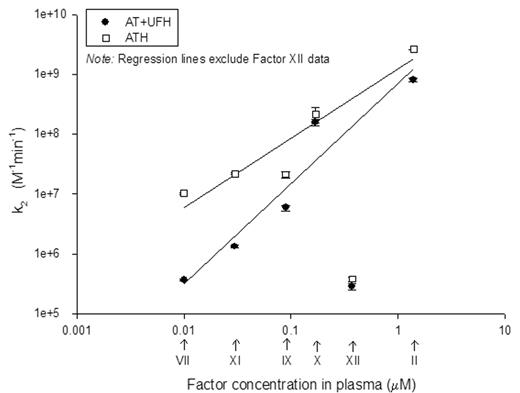Abstract
Heparin is a commonly used anticoagulant in the treatment of thrombosis. We have compared heparinoid-stimulated inhibition rates with the in vivo plasma concentration of antithrombin (AT)-inhibitable coagulation factors. Second order rate constants (k2) for inhibition of activated factors by either AT + unfractionated heparin (AT+UFH) mixtures or a novel covalent complex of AT and heparin (ATH) (
Chan et al, J Biol Chem, 272:22111, 1997
) were determined by discontinuous assay. A plot of k2 values (mean ± SEM; n ≥5) versus the respective human plasma concentration of coagulation factors revealed a linear correlation (with R2 values of 0.93 for AT+UFH and 0.90 for ATH, excluding factor XII), in which neutralization efficiency was proportional to in vivo factor level (see Figure). Anticoagulant actions of AT+UFH and ATH were more oriented towards treatment than prophylaxis since inhibition of cascade end point enzymes (thrombin and factor Xa) was more rapid than factors involved in coagulation initiation (factors VIIa and XIa). However, ATH exhibited more enhanced inhibition rates against factors VIIa, IXa and XIa than against factor Xa and thrombin, suggestive of an improved prophylactic profile compared to AT+UFH. Intriguingly, factor XII did not follow this trend, further challenging its role in the coagulation cascade. The impact of these assertions requires confirmation by in vivo inhibition studies.Disclosure: No relevant conflicts of interest to declare.
Author notes
*
Corresponding author
2006, The American Society of Hematology
2006


This feature is available to Subscribers Only
Sign In or Create an Account Close Modal